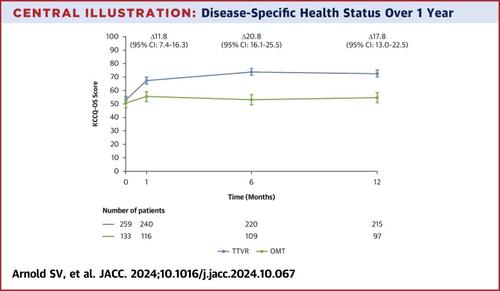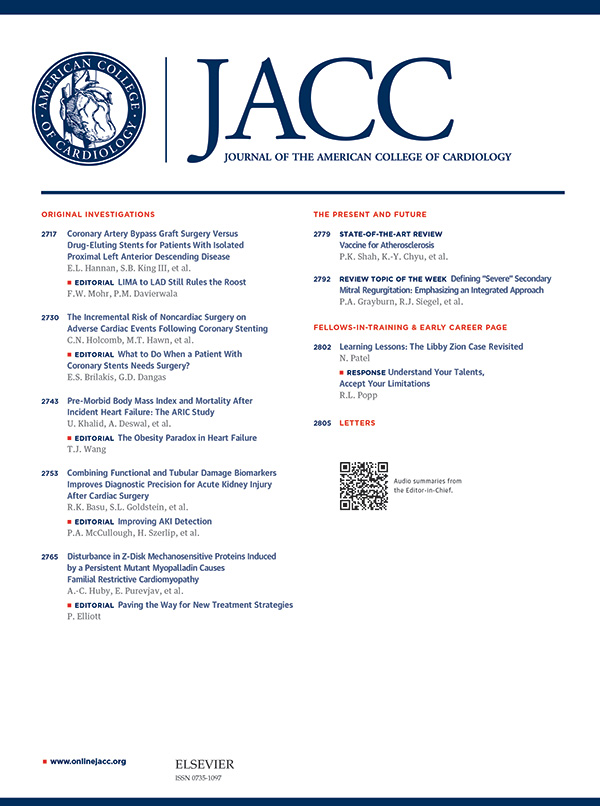Quality of Life After Transcatheter Tricuspid Valve Replacement: 1-Year Results From TRISCEND II Pivotal Trial
IF 21.7
1区 医学
Q1 CARDIAC & CARDIOVASCULAR SYSTEMS
引用次数: 0
Abstract
Background
Severe tricuspid regurgitation (TR) often causes substantial impairment in patient-reported health status (ie, symptoms, physical and social function, and quality of life), which may improve with transcatheter tricuspid valve replacement (TTVR).Objectives
We performed an in-depth analysis of health status of patients enrolled in the TRISCEND (Edwards EVOQUE Transcatheter Tricuspid Valve Replacement: Pivotal Clinical Investigation of Safety and Clinical Efficacy using a Novel Device) II pivotal trial to help quantify the benefit of intervention to patients.Methods
The TRISCEND II pivotal trial randomized 400 patients with symptomatic and severe or greater TR 2:1 to TTVR with the EVOQUE tricuspid valve replacement system plus optimal medical therapy (OMT) or OMT alone. Health status was assessed with the Kansas City Cardiomyopathy Questionnaire and the 36-Item Short Form Health Survey. Changes in health status over 1 year were compared between treatment groups using mixed-effects repeated-measures models.Results
The analysis cohort included 392 patients, of whom 259 underwent attempted TTVR and 133 received OMT alone (mean age 79.2 ± 7.6 years, 75.5% women, 56.1% with massive or torrential TR). Patients had substantially impaired health status at baseline (mean Kansas City Cardiomyopathy Questionnaire Overall Summary Score [KCCQ-OS] 52.1 ± 22.8; mean 36-Item Short Form Health Survey physical component summary score 35.2 ± 8.4). TTVR+OMT patients reported significantly greater improvement in both disease-specific and generic health status at each follow-up time point. Mean between-group differences in the KCCQ-OS favored TTVR+OMT at each time point: 11.8 points (95% CI: 7.4-16.3 points) at 30 days, 20.8 points (95% CI: 16.1-25.5 points) at 6 months, and 17.8 points (95% CI: 13.0-22.5 points) at 1 year. In subgroup analyses, TTVR+OMT improved health status to a greater extent among patients with torrential or massive TR vs severe TR (treatment effect 23.3 vs 22.6 vs 11.3; interaction P = 0.049). At 1 year, 64.6% of TTVR+OMT patients were alive and well (KCCQ-OS ≥60 points and no decline of ≥10 points from baseline) compared with 31.0% with OMT alone.Conclusions
Compared with OMT alone, treatment of patients with symptomatic and severe or greater TR with TTVR+OMT resulted in substantial improvement in patients’ symptoms, function, and quality of life. These benefits were evident 30 days after TTVR, continued to increase through 6 months, and remained durable through 1 year. (TRISCEND II Pivotal Trial [Edwards EVOQUE Transcatheter Tricuspid Valve Replacement: Pivotal Clinical Investigation of Safety and Clinical Efficacy using a Novel Device]; NCT04482062)

经导管三尖瓣置换术后的生活质量:TRISCEND II 关键性试验的 1 年结果
背景严重三尖瓣反流(TR)通常会导致患者报告的健康状况(即症状、身体和社会功能以及生活质量)严重受损,而经导管三尖瓣置换术(TTVR)可能会改善患者的健康状况:方法TRISCEND II关键性试验将400名无症状和严重或大于TR 2:1的患者随机分为使用EVOQUE三尖瓣置换系统加最佳药物治疗(OMT)或仅使用OMT进行TTVR。健康状况通过堪萨斯城心肌病问卷和 36 项简表健康调查进行评估。使用混合效应重复测量模型比较了不同治疗组一年内的健康状况变化。结果分析队列包括392名患者,其中259人接受了尝试性TTVR,133人只接受了OMT(平均年龄79.2±7.6岁,75.5%为女性,56.1%患有大面积或暴发性TR)。基线时,患者的健康状况严重受损(堪萨斯城心肌病问卷总体总分[KCCQ-OS]平均值为(52.1 ± 22.8);36项简表健康调查体格部分总分平均值为(35.2 ± 8.4)。在每个随访时间点,TTVR+OMT患者的疾病特异性和一般健康状况都有明显改善。各时间点的 KCCQ-OS 组间平均差异有利于 TTVR+OMT:30 天时为 11.8 分(95% CI:7.4-16.3 分),6 个月时为 20.8 分(95% CI:16.1-25.5 分),1 年时为 17.8 分(95% CI:13.0-22.5 分)。在亚组分析中,TTVR+OMT能在更大程度上改善暴发性或大面积TR患者与重度TR患者的健康状况(治疗效果23.3 vs 22.6 vs 11.3;交互作用P = 0.049)。1年后,64.6%的TTVR+OMT患者存活良好(KCCQ-OS≥60分,且与基线相比无≥10分的下降),而仅接受OMT治疗的患者存活良好率为31.0%。这些益处在 TTVR 治疗后 30 天就显现出来,6 个月后继续增加,1 年后仍然持续。(TRISCEND II 关键性试验[Edwards EVOQUE 经导管三尖瓣置换术:使用新型设备的安全性和临床疗效的关键临床研究];NCT04482062)
本文章由计算机程序翻译,如有差异,请以英文原文为准。
求助全文
约1分钟内获得全文
求助全文
来源期刊
CiteScore
42.70
自引率
3.30%
发文量
5097
审稿时长
2-4 weeks
期刊介绍:
The Journal of the American College of Cardiology (JACC) publishes peer-reviewed articles highlighting all aspects of cardiovascular disease, including original clinical studies, experimental investigations with clear clinical relevance, state-of-the-art papers and viewpoints.
Content Profile:
-Original Investigations
-JACC State-of-the-Art Reviews
-JACC Review Topics of the Week
-Guidelines & Clinical Documents
-JACC Guideline Comparisons
-JACC Scientific Expert Panels
-Cardiovascular Medicine & Society
-Editorial Comments (accompanying every Original Investigation)
-Research Letters
-Fellows-in-Training/Early Career Professional Pages
-Editor’s Pages from the Editor-in-Chief or other invited thought leaders

 求助内容:
求助内容: 应助结果提醒方式:
应助结果提醒方式:


